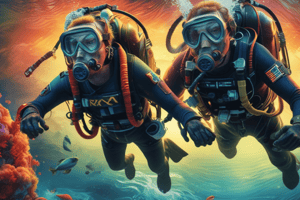Podcast
Questions and Answers
What is the primary cause of nitrogen narcosis?
What is the primary cause of nitrogen narcosis?
- Rapid changes in depth
- High partial pressure of nitrogen in the bloodstream (correct)
- Prolonged exposure to excessive oxygen
- Insufficient physical fitness
Which of the following is a prevention method for nitrogen narcosis?
Which of the following is a prevention method for nitrogen narcosis?
- Breathing gases with lower nitrogen content (correct)
- Diving at depths shallower than 10 meters
- Rapid ascents during emergencies
- ignoring symptoms of nitrogen narcosis
What is the first step in managing symptoms of nitrogen narcosis?
What is the first step in managing symptoms of nitrogen narcosis?
- Administering oxygen therapy
- Providing supportive care, such as fluids and pain management
- Recognizing and responding to symptoms early (correct)
- Ignoring symptoms and continuing the dive
What is the primary effect of oxygen toxicity?
What is the primary effect of oxygen toxicity?
Which of the following is a key aspect of diving protocols?
Which of the following is a key aspect of diving protocols?
Flashcards are hidden until you start studying
Study Notes
Compression Decompression Sickness
Nitrogen Narcosis
- Also known as "raptures of the deep"
- Caused by high partial pressure of nitrogen in the bloodstream
- Effects:
- Euphoria, dizziness, and confusion
- Impaired judgment and coordination
- Increased risk of accidents
- Can lead to loss of consciousness and death
- Occurs at depths > 30 meters (100 feet)
Prevention Methods
- Gradual compression and decompression
- Dive planning and monitoring
- Safety stops during ascent
- Avoiding rapid changes in depth
- Breathing gases with lower nitrogen content (e.g., heliox, trimix)
- Physical fitness and health screening
Symptom Management
- Recognize and respond to symptoms early
- Stop the dive and ascend slowly
- Administer oxygen therapy
- Provide supportive care (e.g., fluids, pain management)
- Monitor for signs of worsening condition
- Seek medical attention if symptoms persist or worsen
Oxygen Toxicity
- Caused by excessive oxygen partial pressure
- Effects:
- Convulsions
- Lung damage
- Respiratory failure
- Risk factors:
- High partial pressure of oxygen
- Prolonged exposure
- Depth and duration of dive
- Prevention:
- Monitoring oxygen levels
- Avoiding excessive oxygen exposure
- Using oxygen-safe equipment
Diving Protocols
- Establishing a safe maximum operating depth (MOD)
- Conducting safety stops and gradual ascents
- Monitoring dive time and gas supply
- Performing pre-dive safety checks and equipment inspections
- Following established emergency procedures
- Maintaining accurate dive logs and records
Nitrogen Narcosis
- Also known as "raptures of the deep"
- Caused by high partial pressure of nitrogen in the bloodstream
- Occurs at depths > 30 meters (100 feet)
- Effects:
- Euphoria, dizziness, and confusion
- Impaired judgment and coordination
- Increased risk of accidents
- Can lead to loss of consciousness and death
Prevention Methods
- Gradual compression and decompression
- Dive planning and monitoring
- Safety stops during ascent
- Avoiding rapid changes in depth
- Breathing gases with lower nitrogen content (e.g., heliox, trimix)
- Physical fitness and health screening
Symptom Management
- Recognize and respond to symptoms early
- Stop the dive and ascend slowly
- Administer oxygen therapy
- Provide supportive care (e.g., fluids, pain management)
- Monitor for signs of worsening condition
- Seek medical attention if symptoms persist or worsen
Oxygen Toxicity
- Caused by excessive oxygen partial pressure
- Effects:
- Convulsions
- Lung damage
- Respiratory failure
- Risk factors:
- High partial pressure of oxygen
- Prolonged exposure
- Depth and duration of dive
- Prevention:
- Monitoring oxygen levels
- Avoiding excessive oxygen exposure
- Using oxygen-safe equipment
Diving Protocols
- Establishing a safe maximum operating depth (MOD)
- Conducting safety stops and gradual ascents
- Monitoring dive time and gas supply
- Performing pre-dive safety checks and equipment inspections
- Following established emergency procedures
- Maintaining accurate dive logs and records
Studying That Suits You
Use AI to generate personalized quizzes and flashcards to suit your learning preferences.



